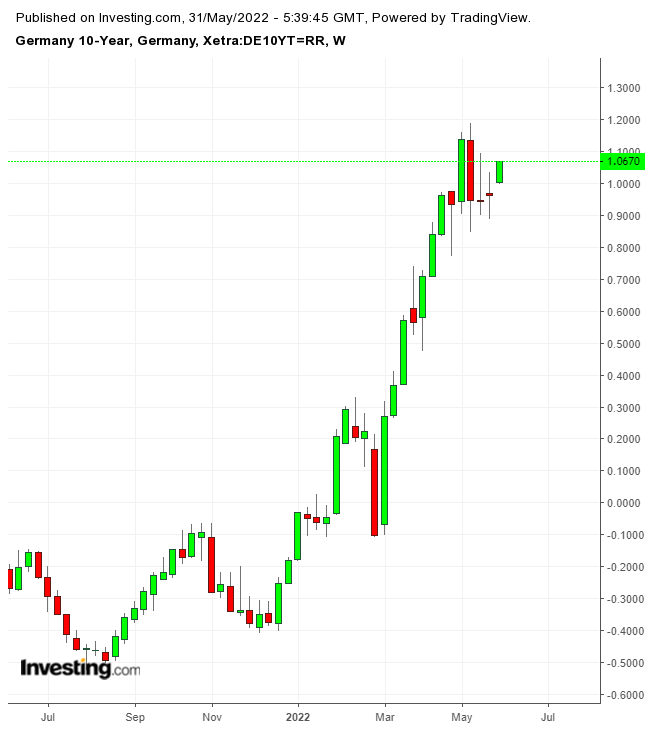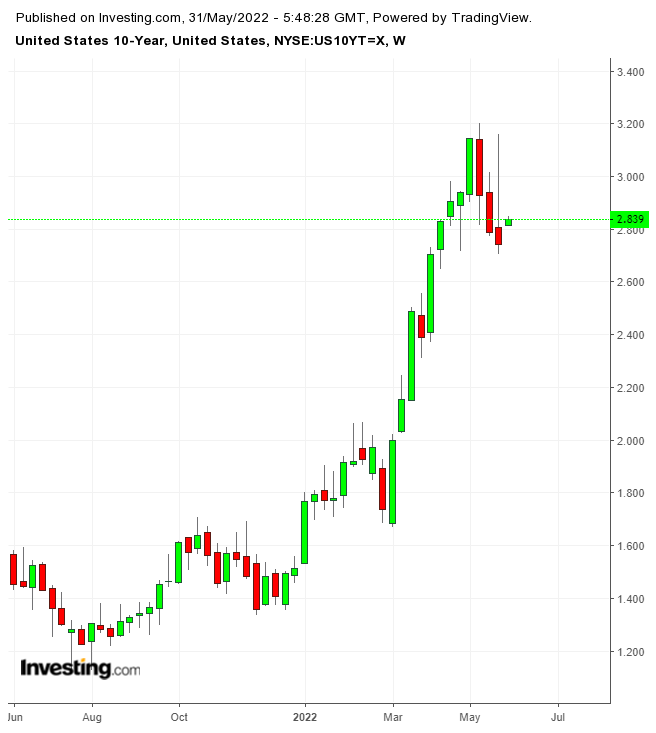Surging inflation and sinking bond markets have shifted to Europe this week, as initial CPI readings in the European Union point to accelerating price increases of more than 8% on the year.
German inflation soared to 8.7% in May, as measured by the index of consumer prices harmonized to EU standards, from 7.8% in April—its highest level since the oil crisis nearly five decades ago.
In Spain, the harmonized CPI was up 8.5% in May after 8.3% in April. In both cases, it was higher than forecast.

The inflation reports hit government bonds. Yield on Germany’s 10-year bond, which functions as a benchmark for the eurozone as a whole, surged 10 basis points on Monday, to nearly 1.05%. Yield on Spain’s 10-year bond jumped nearly 12 bps, to close just under 2.12%.
The inflation news comes as European Central Bank policymakers grow more sharply divided between hawks demanding a half-point increase in July and doves urging cautious quarter-point moves.
Philip Lane, the former head of Ireland’s central bank, who is now chief economist at the ECB, came out Monday calling for two quarter-point increases in the deposit rate to get out of negative territory by the end of September after the ECB ends bond purchases in July. In an interview with Spain's Cinco Dias newspaper, Lane stated:
“The discussion will be had, but our current assessment of the situation, where we think the medium-term inflation outlook is in line with our 2% target, calls for a gradual approach to normalization.”
As a member of the executive board, Lane is an influential voice in the ECB governing council. He is even more dovish than ECB President Christine Lagarde, who tries to stay in the middle of the road but has set out the cautious roadmap Lane is following.
The reading for inflation in the eurozone as a whole is due out Tuesday, with an 8% annual increase likely, as economists raise their forecasts for the year.
Some analysts expect the quarter-point hikes to continue at each meeting through the end of the year.
In an indication that inflation is affecting government bond investors, France’s debt agency last week innovated a green bond indexed to inflation. The 15-year bond debuted with a yield of minus 0.415% and raised €4 billion ($4.3 billion) on offers of more than €27 billion ($29 billion).
The €4 billion is the maximum amount allowed for an indexed issue, but strong demand enabled the government to lower the initial yield by 3 bps.
Data Points To Possible US Inflation Peak
In the US, the Memorial Day holiday meant no trading on Monday and a shortened session on Friday. The personal consumer expenditure index measure of inflation released on Friday showed the core increase on the year at 4.9% in April, in line with forecasts.

Investors were happy to take the decline from the March core rate of 5.2% as a sign that inflation may have peaked. Yield on the benchmark 10-year Treasury note slipped, but by less than 1 bp, to 2.743%.
May jobs figures are due out Friday, but they could have less impact than usual because the Federal Reserve has already programmed in two half-point hikes for June and July.
Still, any clues as to a decline in hiring will be put into the inflation forecasting hopper.
